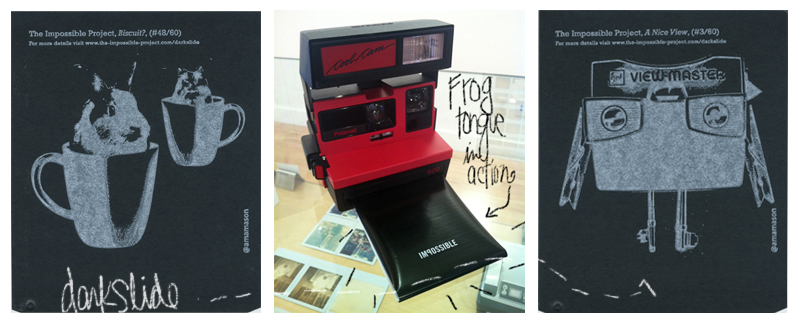Do you have an old Polaroid camera sitting around your house you got at a thrift store a few years ago? Did ya know you can use it?! There's something thrillingly nostalgic about Polaroid, isn't there? Unfortunately Polaroid quit making their instant films a few years ago but luckily for us
The Impossible Project has made it their goal to re-invent some fun and beautiful instant films to keep the instant dream alive! I'm by no means an expert on the subject but I do love instant photography and want to do my part to spread the love. Here is a little information to help you get started!
When you hear folks talking about instant film they are probably talking about one of two types: integral or pack film.
Integral film is self contained. It has chemicals inside it that don't leak out (unless something has gone wrong!). It's what comes to mind when you hear the word "Polaroid". With pack film you have to peel one layer off to see an image and the chemistry is on the peeled paper, which is why it's sometimes called peel apart. These two films can't work in the same cameras. In this post we'll focus on integral film cameras.
Here are the most common cameras that take integral film!

These cameras are typically called "600 cameras".
- They are the no fuss point n shoot instant film cameras.
- Most models come with built in flash, a darkening/lightening wheel, and some models have a primitive macro setting.
- The camera on the top left corner is called a 680. It's my favorite of all the polaroid cameras. As you can see it folds up real sexy like, has a flash you can turn on or off, and you control the focus! Luckily for me I married into ownership of this gem!
- There are tons of different models of these cameras but you probably get the general idea.
- These cameras take Polaroid 600, which is no longer produced and rather expensive on eBay. Luckily for us The Impossible Project makes the following films for these cameras, pictured below,
PX680,
PX600UV+ , and
PX600.

Pictured above are a few different models of SX-70 cameras.
- Most models of SX-70 cameras fold up, which I think is nice and really sets these apart. They are my favorite kind of instant film camera to shoot with.
- The fold up models are an SLR, so they are a fancier instant film camera with more features.
- Most SX-70 cameras do not come with flash attached like the 600 models. You can purchase either a flash unit to attach to it, or flash bars to provide flash though.
- They're just so cute aren't they?!
- The Impossible Project makes a film called
PX70 that is made specifically for these cameras but you can also use the previously mentioned films, the
PX680,
PX600UV,
PX600, and Polaroid 600 with a special filter called a Neutral Density or
ND filter you put over your film. More on that later.
The Spectra is a lot like the 600 cameras but it takes a wider format of integral film. More to love!
- The Spectra cameras I own have some really cool features like a self timer, and the ability to turn the flash off.
- This camera can rather easily make double exposures!! A double exposure is when you take two pictures on one piece of film. There's an awesome tutorial on how to do that
here.
- The Impossible Project makes films just for this camera. They are
PZ680,
PZ600, and
PZ600UV.
But how does it work?! Magic. I mean, really it is magic with some science behind it ;) You pop in the cartridge of film, close the mouth of the camera and hit the shutter button...click...whirl....you have a picture in your hands! It's that easy! The film has chemicals inside of it that spread when the image is being ejected out of the camera.
Photojojo made a really fun blog posts explaining exactly how that works, you can see it
here.
Most of these cameras can be found easily and cheaply at thrift stores or on Craigslist. The only way to test to see if the camera works is to insert a pack of film and take it for a spin though, so it can be a gamble to buy them this way. If you want a safe bet, The Impossible Project sells
refurbished and guaranteed to work ones! Hooray!
Still have questions? Take a peek at my other two blog posts where I'll discuss
pack film, show examples of the
different films and talk a little bit about
accessories!
If you feel well informed and want to get your grubby little hands on a camera and some film,
get to shopping!


























